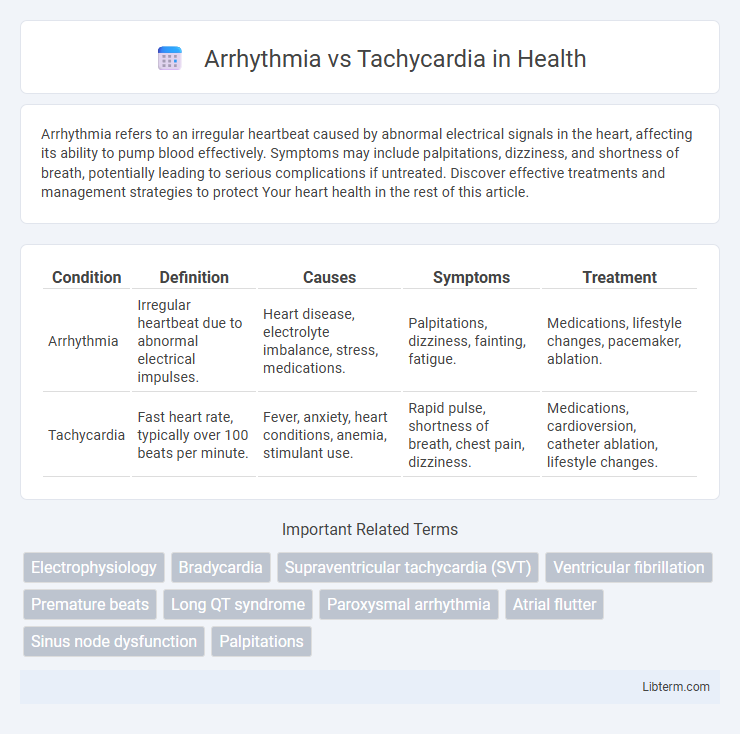Arrhythmia refers to an irregular heartbeat caused by abnormal electrical signals in the heart, affecting its ability to pump blood effectively. Symptoms may include palpitations, dizziness, and shortness of breath, potentially leading to serious complications if untreated. Discover effective treatments and management strategies to protect Your heart health in the rest of this article.
Table of Comparison
| Condition | Definition | Causes | Symptoms | Treatment |
|---|---|---|---|---|
| Arrhythmia | Irregular heartbeat due to abnormal electrical impulses. | Heart disease, electrolyte imbalance, stress, medications. | Palpitations, dizziness, fainting, fatigue. | Medications, lifestyle changes, pacemaker, ablation. |
| Tachycardia | Fast heart rate, typically over 100 beats per minute. | Fever, anxiety, heart conditions, anemia, stimulant use. | Rapid pulse, shortness of breath, chest pain, dizziness. | Medications, cardioversion, catheter ablation, lifestyle changes. |
Understanding Arrhythmia: Definition and Types
Arrhythmia refers to an irregular heartbeat, encompassing a variety of conditions where the heart rhythm deviates from normal patterns. Common types include atrial fibrillation, characterized by rapid and irregular beating of the atria, and bradycardia, marked by abnormally slow heart rates. Tachycardia, a specific form of arrhythmia, involves abnormally fast heart rates typically exceeding 100 beats per minute, highlighting the diverse manifestations of arrhythmic disorders.
What Is Tachycardia? Overview and Classification
Tachycardia refers to a condition where the heart beats faster than normal, typically over 100 beats per minute in adults, indicating an abnormal increase in heart rate. It is classified into several types, including atrial tachycardia, ventricular tachycardia, and supraventricular tachycardia, each arising from different areas of the heart and possessing distinct clinical implications. Understanding tachycardia's classification helps guide diagnosis, treatment options, and management strategies to address the underlying cause effectively.
Key Differences Between Arrhythmia and Tachycardia
Arrhythmia refers to any irregularity in the heart's rhythm, including too fast, too slow, or erratic beats, while tachycardia specifically denotes a heart rate exceeding 100 beats per minute. Arrhythmia encompasses a broad spectrum of disorders such as atrial fibrillation, bradycardia, and premature contractions, whereas tachycardia is categorized into types like supraventricular and ventricular tachycardia based on the heart's origin of the fast rhythm. Understanding these distinctions is critical for accurate diagnosis and targeted treatment in cardiovascular care.
Common Causes of Arrhythmia and Tachycardia
Arrhythmia and tachycardia are types of abnormal heart rhythms with distinct common causes. Arrhythmia often results from electrolyte imbalances, coronary artery disease, or structural heart defects, while tachycardia typically arises due to fever, anemia, hyperthyroidism, or excessive caffeine intake. Both conditions may also stem from heart valve disorders or stress-induced sympathetic nervous system activation.
Recognizing Symptoms: Arrhythmia vs Tachycardia
Arrhythmia involves irregular heartbeats that can be too fast, too slow, or erratic, often causing palpitations, dizziness, or fainting. Tachycardia specifically refers to a faster-than-normal heart rate, typically above 100 beats per minute, resulting in symptoms like rapid pulse, chest pain, and shortness of breath. Differentiating these conditions requires monitoring heart rhythm patterns and symptom triggers to ensure accurate diagnosis and treatment.
Risk Factors for Arrhythmia and Tachycardia
Arrhythmia risk factors include coronary artery disease, high blood pressure, diabetes, and electrolyte imbalances, which disrupt normal heart rhythm. Tachycardia is commonly linked to fever, anemia, hyperthyroidism, excessive caffeine or alcohol intake, and stress, all of which increase heart rate abnormally. Both conditions may be exacerbated by structural heart defects, obesity, and a history of heart surgery or heart attack.
Diagnostic Methods for Heart Rhythm Disorders
Electrocardiogram (ECG) remains the primary diagnostic tool for differentiating arrhythmia and tachycardia by recording the heart's electrical activity to identify irregular rhythms or elevated heart rates exceeding 100 beats per minute. Holter monitors provide continuous 24- to 48-hour ECG recordings, capturing intermittent arrhythmias or tachycardia episodes that may not appear during a standard ECG. Advanced diagnostic techniques such as event monitors, stress tests, and electrophysiological studies offer detailed evaluation of transient arrhythmic events and underlying conduction abnormalities.
Treatment Options: Arrhythmia Compared to Tachycardia
Treatment options for arrhythmia vary based on the type and severity but commonly include antiarrhythmic medications, catheter ablation, and implantable devices like pacemakers or defibrillators. Tachycardia treatment often targets the underlying cause and may involve beta-blockers, calcium channel blockers, or synchronized cardioversion. Managing arrhythmia requires precise diagnosis, as some modalities overlap with tachycardia therapy but differ in approach depending on whether the heart rhythm disorder is irregular or excessively fast.
Prevention Strategies for Heart Rhythm Abnormalities
Preventing arrhythmia and tachycardia involves maintaining a healthy heart through regular cardiovascular exercise, balanced diet low in sodium and saturated fats, and stress management techniques such as mindfulness or yoga. Avoiding excessive caffeine, alcohol, and tobacco reduces episodes of abnormal heart rhythms by minimizing heart stimulation and inflammation. Regular monitoring of blood pressure, cholesterol, and electrolyte levels supports early detection and management of conditions contributing to heart rhythm abnormalities.
When to Seek Medical Attention for Heart Palpitations
Heart palpitations require immediate medical attention if accompanied by chest pain, dizziness, shortness of breath, or fainting, as these could indicate severe Arrhythmia or Tachycardia. Persistent or irregular heartbeats lasting more than a few minutes should prompt evaluation by a cardiologist to prevent complications such as stroke or heart failure. Monitoring symptoms with an ECG or Holter monitor is essential for accurate diagnosis and timely treatment of underlying cardiac conditions.
Arrhythmia Infographic

 libterm.com
libterm.com